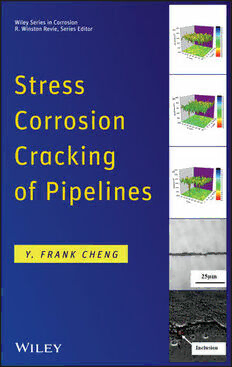
Stress Corrosion Cracking of Pipelines PDF
Preview Stress Corrosion Cracking of Pipelines
Stress Corrosion Cracking of Pipelines WILEYSERIESINCORROSION R.WinstonRevie,SeriesEditor CorrosionInspectionandMonitoring·PierreR.Roberge CorrosionResistanceofAluminumandMagnesiumAlloys:Understanding,Performance, andTesting·EdwardGhali MicrobiologicallyInfluencedCorrosion·BrendaJ.LittleandJasonS.Lee CorrosionResistanceofAluminumandMagnesiumAlloys·EdwardGhali MetallurgyandCorrosionControlinOilandGasProduction·RobertHeidersbach GreenCorrosionInhibitors:TheoryandPractice·V.S.Sastri HeterogenousElectodeProcessesandLocalizedCorrosion·YongjunTan StressCorrosionCrackingofPipelines·Y.FrankCheng Stress Corrosion Cracking of Pipelines Y. Frank Cheng ProfessorandCanadaResearchChair inPipelineEngineering UniversityofCalgary A JohnWiley&Sons,Inc.,Publication Copyright(cid:2)C 2013byJohnWiley&Sons,Inc.Allrightsreserved. PublishedbyJohnWiley&Sons,Inc.,Hoboken,NewJersey. PublishedsimultaneouslyinCanada. Nopartofthispublicationmaybereproduced,storedinaretrievalsystem,ortransmittedinanyformor byanymeans,electronic,mechanical,photocopying,recording,scanning,orotherwise,exceptas permittedunderSection107or108ofthe1976UnitedStatesCopyrightAct,withouteithertheprior writtenpermissionofthePublisher,orauthorizationthroughpaymentoftheappropriateper-copyfeeto theCopyrightClearanceCenter,Inc.,222RosewoodDrive,Danvers,MA01923,(978)750-8400, fax(978)750-4470,oronthewebatwww.copyright.com.RequeststothePublisherforpermission shouldbeaddressedtothePermissionsDepartment,JohnWiley&Sons,Inc.,111RiverStreet,Hoboken, NJ07030,(201)748-6011,fax(201)748-6008,oronlineathttp://www.wiley.com/go/permission. LimitofLiability/DisclaimerofWarranty:Whilethepublisherandauthorhaveusedtheirbesteffortsin preparingthisbook,theymakenorepresentationsorwarrantieswithrespecttotheaccuracyor completenessofthecontentsofthisbookandspecificallydisclaimanyimpliedwarrantiesof merchantabilityorfitnessforaparticularpurpose.Nowarrantymaybecreatedorextendedbysales representativesorwrittensalesmaterials.Theadviceandstrategiescontainedhereinmaynotbesuitable foryoursituation.Youshouldconsultwithaprofessionalwhereappropriate.Neitherthepublishernor authorshallbeliableforanylossofprofitoranyothercommercialdamages,includingbutnotlimitedto special,incidental,consequential,orotherdamages. Forgeneralinformationonourotherproductsandservicesorfortechnicalsupport,pleasecontactour CustomerCareDepartmentwithintheUnitedStatesat(800)762-2974,outsidetheUnitedStatesat (317)572-3993orfax(317)572-4002. Wileyalsopublishesitsbooksinavarietyofelectronicformats.Somecontentthatappearsinprintmay notbeavailableinelectronicbooks.FormoreinformationaboutWileyproducts,visitourwebsiteat www.wiley.com. LibraryofCongressCataloging-in-PublicationData Cheng,Y.Frank,1969– Stresscorrosioncrackingofpipelines/Y.FrankCheng. pagescm Includesbibliographicalreferencesandindex. ISBN978-1-118-02267-2(cloth) 1.Pipelines–Corrosion. 2.Pipelines–Cracking. 3.Steel–Corrosion. I.Title. TJ930.C5452013 621.8(cid:3)672–dc23 2012035723 PrintedintheUnitedStatesofAmerica 10 9 8 7 6 5 4 3 2 1 Tomywife,Jianshu(Jenny),andmyson,Winston Contents Foreword xiii Preface xv ListofAbbreviationsandSymbols xix 1 Introduction 1 1.1 Pipelinesas“EnergyHighways” / 2 1.2 PipelineSafetyandIntegrityManagement / 3 1.3 PipelineStressCorrosionCracking / 3 References / 5 2 FundamentalsofStressCorrosionCracking 7 2.1 DefinitionofStressCorrosionCracking / 7 2.2 SpecificMetal–EnvironmentCombinations / 9 2.3 MetallurgicalAspectsofSCC / 11 2.3.1 EffectofStrengthofMaterialsonSCC / 11 2.3.2 EffectofAlloyingCompositiononSCC / 11 2.3.3 EffectofHeatTreatmentonSCC / 11 2.3.4 GrainBoundaryPrecipitation / 12 2.3.5 GrainBoundarySegregation / 12 vii viii CONTENTS 2.4 ElectrochemistryofSCC / 13 2.4.1 SCCThermodynamics / 13 2.4.2 SCCKinetics / 14 2.5 SCCMechanisms / 15 2.5.1 SCCInitiationMechanisms / 15 2.5.2 Dissolution-BasedSCCPropagation / 16 2.5.3 MechanicalFracture–BasedSCCPropagation / 18 2.6 EffectsofHydrogenonSCCandHydrogenDamage / 20 2.6.1 SourcesofHydrogen / 20 2.6.2 CharacteristicsofHydrogeninMetals / 21 2.6.3 TheHydrogenEffect / 21 2.6.4 MechanismsofHydrogenDamage / 25 2.7 RoleofMicroorganismsinSCC / 27 2.7.1 MicrobiallyInfluencedCorrosion / 27 2.7.2 MicroorganismsInvolvedinMIC / 29 2.7.3 RoleofMICinSCCProcesses / 31 2.8 CorrosionFatigue / 32 2.8.1 FeaturesofFatigueFailure / 33 2.8.2 FeaturesofCorrosionFatigue / 34 2.8.3 FactorsAffectingCFandCFManagement / 35 2.9 ComparisonofSCC,HIC,andCF / 35 References / 37 3 UnderstandingPipelineStressCorrosionCracking 43 3.1 Introduction / 43 3.2 PracticalCaseHistoryofSCCinPipelines / 44 3.2.1 Case1:SCCofEnbridgeGlenavonPipelines (SCCinanOilPipeline) / 45 3.2.2 Case2:SCCofWilliamsLakePipelines(SCCinaGas Pipeline) / 46 3.3 GeneralFeaturesofPipelineSCC / 46 3.3.1 High-pHSCCofPipelines / 47 3.3.2 NearlyNeutral–pHSCCofPipelines / 48 3.3.3 CrackingCharacteristics / 48 3.4 ConditionsforPipelineSCC / 50 3.4.1 CorrosiveEnvironments / 50 3.4.2 SusceptibleLinePipeSteels / 53 3.4.3 Stress / 58 CONTENTS ix 3.5 RoleofPressureFluctuationinPipelines:SCCorCorrosion Fatigue? / 62 References / 68 4 NearlyNeutral–pHStressCorrosionCracking ofPipelines 73 4.1 Introduction / 73 4.2 PrimaryCharacteristics / 73 4.3 ContributingFactors / 75 4.3.1 Coatings / 75 4.3.2 CathodicProtection / 79 4.3.3 SoilCharacteristics / 81 4.3.4 Microorganisms / 83 4.3.5 Temperature / 85 4.3.6 Stress / 85 4.3.7 SteelMetallurgy / 88 4.4 InitiationofStressCorrosionCracksfromCorrosionPits / 89 4.5 StressCorrosionCrackPropagationMechanism / 96 4.5.1 RoleofHydrogeninEnhancedCorrosion ofSteels / 96 4.5.2 Potential-DependentNearlyNeutral–pHSCCof Pipelines / 99 4.5.3 PipelineSteelsinNearlyNeutral–pHSolutions:Always ActiveDissolution? / 101 4.6 ModelsforPredictionofNearlyNeutral–pHSCCPropagation / 104 References / 111 5 High-pHStressCorrosionCrackingofPipelines 117 5.1 Introduction / 117 5.2 PrimaryCharacteristics / 117 5.3 ContributingFactors / 118 5.3.1 Coatings / 118 5.3.2 CathodicProtection / 119 5.3.3 SoilCharacteristics / 123 5.3.4 Microorganisms / 125 5.3.5 Temperature / 125 5.3.6 Stress / 125 5.3.7 Metallurgies / 128 x CONTENTS 5.4 MechanismsforStressCorrosionCrackInitiation / 128 5.4.1 ElectrochemicalCorrosionMechanismofPipelineSteels inaThinLayerofCarbonate–BicarbonateElectrolyte TrappedUnderaDisbondedCoating / 128 5.4.2 ConceptualModelforInitiationofStressCorrosionCracks inaHigh-pHCarbonate–BicarbonateElectrolyteUndera DisbondedCoating / 133 5.5 MechanismsforStressCorrosionCrackPropagation / 137 5.5.1 EnhancedAnodicDissolutionataCrackTip / 137 5.5.2 EnhancedPittingCorrosionataCrackTip / 143 5.5.3 RelevancetoGrainBoundaryStructure / 144 5.6 ModelsforthePredictionofaHigh-pHStressCorrosionCrack GrowthRate / 144 References / 145 6 StressCorrosionCrackingofPipelinesinAcidicSoilEnvironments 149 6.1 Introduction / 149 6.2 PrimaryCharacteristics / 150 6.3 ElectrochemicalCorrosionMechanismofPipelineSteelsinAcidic SoilSolutions / 151 6.4 MechanismsforInitiationandPropagationofStressCorrosion Cracks / 151 6.5 EffectofStrainRateontheSCCofPipelinesinAcidicSoils / 154 References / 157 7 StressCorrosionCrackingatPipelineWelds 159 7.1 Introduction / 159 7.2 FundamentalsofWeldingMetallurgy / 160 7.2.1 WeldingProcesses / 160 7.2.2 WeldingSolidificationandMicrostructure / 160 7.2.3 ParametersAffectingtheWeldingProcess / 162 7.2.4 DefectsattheWeld / 162 7.3 PipelineWelding:MetallurgicalAspects / 163 7.3.1 X70SteelWeld / 163 7.3.2 X80SteelWeld / 163 7.3.3 X100SteelWeld / 164 7.4 PipelineWelding:MechanicalAspects / 164 7.4.1 ResidualStress / 164 7.4.2 HardnessoftheWeld / 166 CONTENTS xi 7.5 PipelineWelding:EnvironmentalAspects / 170 7.5.1 IntroductionofHydrogenintoWelds / 170 7.5.2 CorrosionatWelds / 172 7.5.3 ElectrochemistryofLocalizedCorrosionatPipeline Welds / 173 7.6 SCCatPipelineWelds / 178 7.6.1 EffectsofMaterialPropertiesandMicrostructure / 178 7.6.2 EffectsoftheWeldingProcess / 179 7.6.3 HydrogenSulfideSCCofPipelineWelds / 179 References / 180 8 StressCorrosionCrackingofHigh-StrengthPipelineSteels 185 8.1 Introduction / 185 8.2 DevelopmentofHigh-StrengthSteelPipelineTechnology / 186 8.2.1 EvolutionofPipelineSteels / 186 8.2.2 High-StrengthSteelsinaGlobalPipeline Application / 187 8.3 MetallurgyofHigh-StrengthPipelineSteels / 189 8.3.1 ThermomechanicalControlledProcessing / 189 8.3.2 AlloyingTreatment / 189 8.3.3 MicrostructureofHigh-StrengthSteels / 190 8.3.4 MetallurgicalDefects / 192 8.4 SusceptibilityofHigh-StrengthSteelstoHydrogenDamage / 193 8.4.1 HydrogenBlisteringandHICofHigh-StrengthPipeline Steels / 193 8.4.2 HydrogenPermeationBehaviorofHigh-Strength PipelineSteels / 196 8.5 MetallurgicalMicroelectrochemistry ofHigh-StrengthPipelineSteels / 199 8.5.1 MicroelectrochemicalActivityatMetallurgical Defects / 199 8.5.2 PreferentialDissolutionandPittingCorrosion AroundInclusions / 203 8.6 StrainAgingofHigh-StrengthSteelsandItsImplicationon PipelineSCC / 207 8.6.1 BasicsofStrainAging / 208 8.6.2 StrainAgingofHigh-StrengthPipelineSteels / 212 8.6.3 EffectofStrainAgingonSCCofHigh-StrengthPipeline Steels / 214
